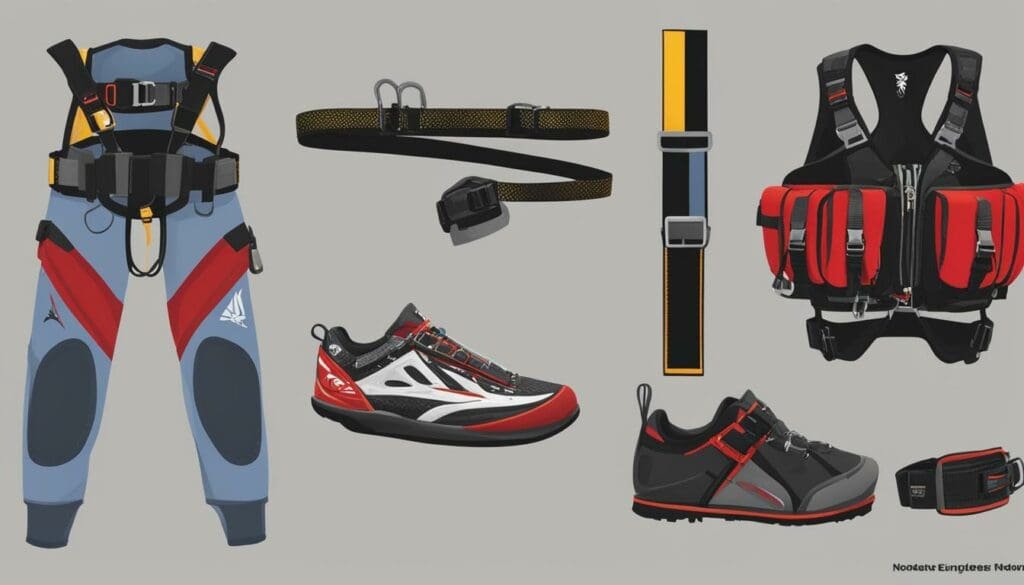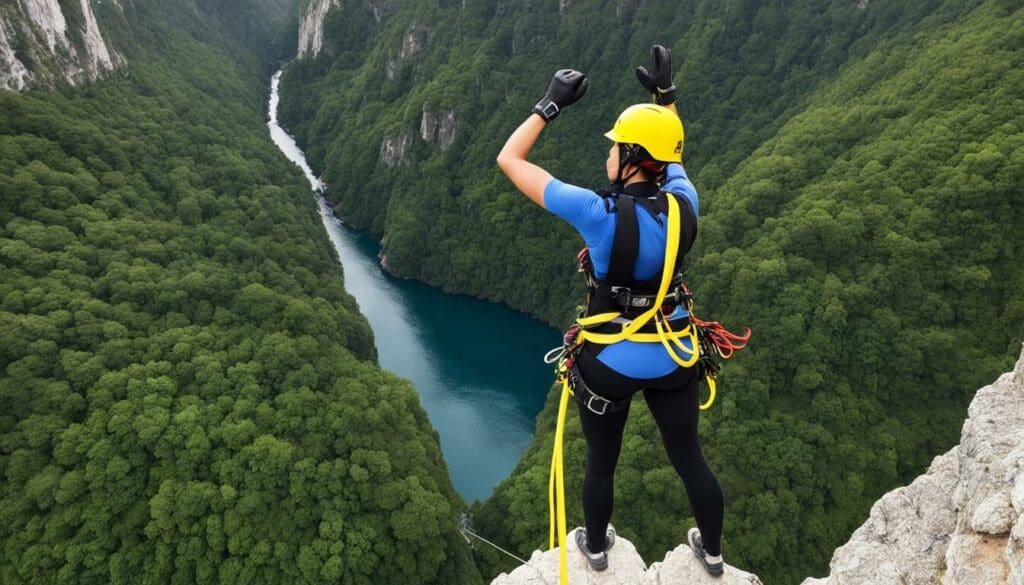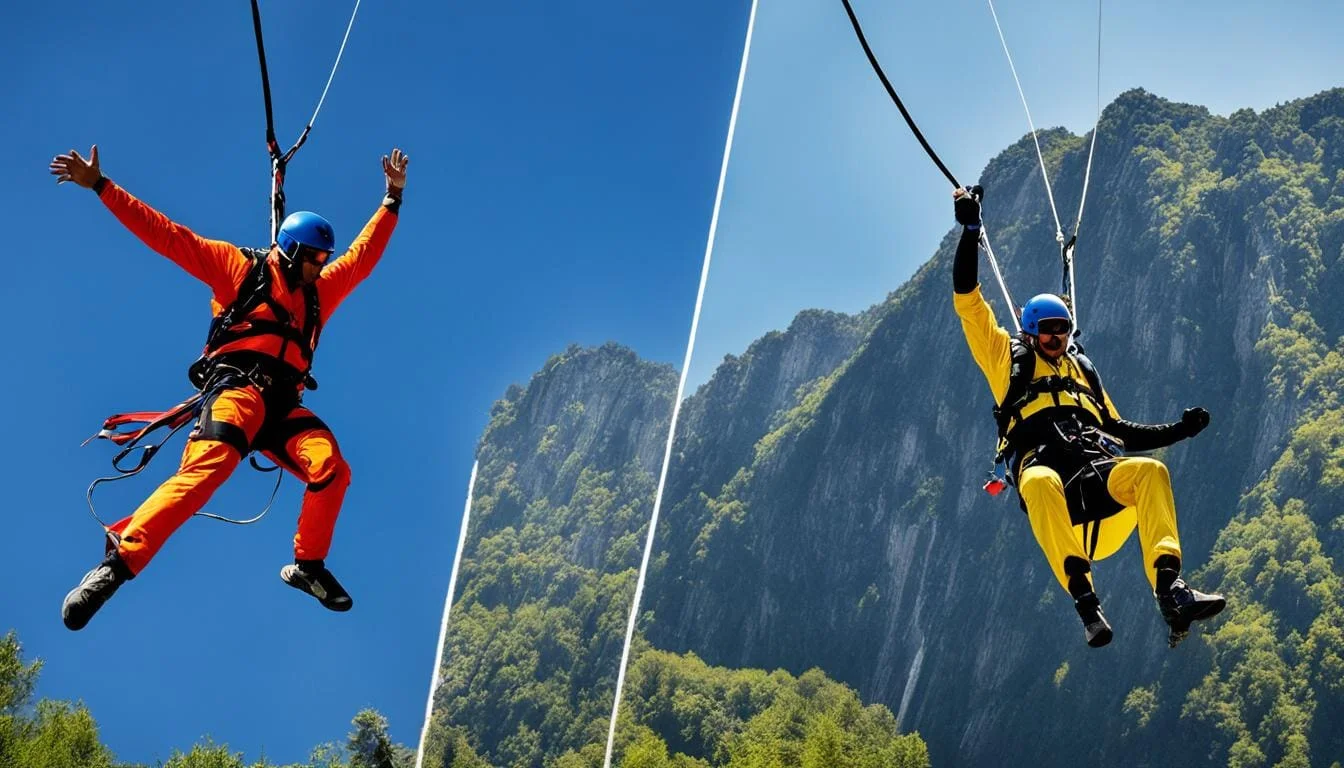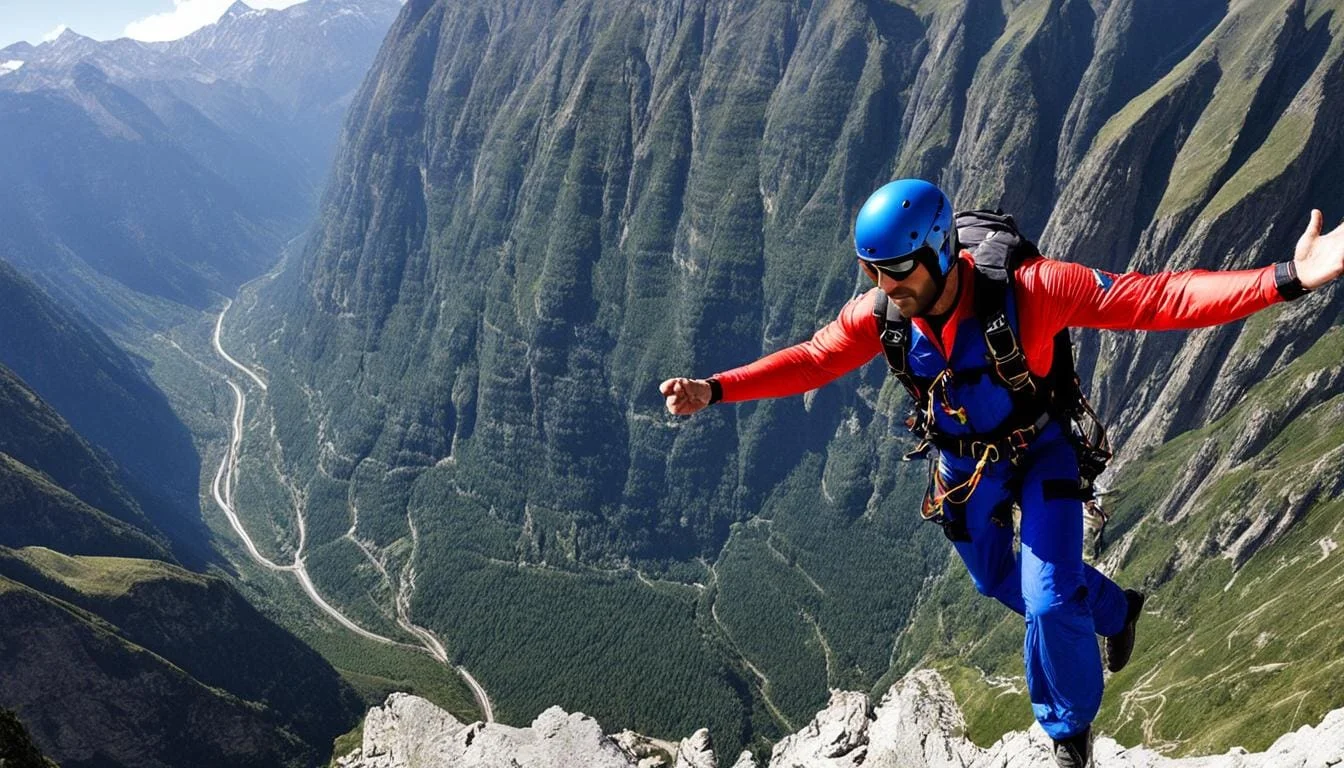Bungee jumping and BASE jumping are exhilarating extreme sports that offer a unique thrill to adrenaline-seeking enthusiasts. Both activities involve jumping from a height, but there are significant differences between the two. But a question that often arises, is “how does bungee jumping differ from base jumping? In this article, we will delve into the varying aspects of bungee jumping and BASE jumping, providing a comprehensive understanding of how they differ and what sets them apart.
Key Takeaways:
Defining Bungee Jumping and BASE Jumping
Bungee jumping and BASE jumping are two exhilarating activities that involve jumping from a height, but they have distinct differences. Understanding the origins and evolution of these sports provides valuable context for their contrasting characteristics.
The Origins of Bungee Jumping
Bungee jumping originated in the late 1970s when members of the Oxford University Dangerous Sports Club performed the first modern bungee jump from the Clifton Suspension Bridge in Bristol. This daring leap marked the beginning of a thrilling new adventure sport that would capture the imagination of adrenaline enthusiasts worldwide.
The Evolution of BASE Jumping
BASE jumping has its roots in the same era, with pioneering skydiver Carl Boenish making significant contributions to its development. In the late 1970s, Boenish filmed the first jumps utilizing ram-air parachutes and introduced the term “BASE,” representing the four categories of fixed objects from which individuals can jump. These categories include buildings, antennas, spans (bridges), and earth (cliffs). Boenish’s efforts propelled BASE jumping into the extreme sports arena, attracting a dedicated community of daredevils.
By examining the origins and evolution of bungee jumping and BASE jumping, we gain a deeper appreciation for their unique histories and the distinct experiences they offer. Let’s delve further into the equipment, safety, risks, and more to understand these thrilling activities.
Equipment and Preparation
When it comes to bungee jumping and BASE jumping, having the right equipment and being properly prepared is essential for a safe and exhilarating experience. Let’s take a closer look at the safety gear and precautions involved in these extreme sports, as well as the training and skill requirements for each.
Safety Gear and Precautions
Bungee jumping requires specific safety gear to ensure a successful jump. This includes professional-quality bungee cords, harnesses, carabiners, and shackles. These components are designed to provide a secure and controlled descent, minimizing the risk of injury during the jump and ensuring that participants can enjoy the thrill of the freefall with peace of mind.
BASE jumping, on the other hand, involves a different set of safety considerations. Jumpers rely on a parachute to break their fall after leaping from a fixed object. It is crucial to have a properly functioning parachute and suitable canopy control skills to ensure a safe landing.
Regardless of the activity, both bungee jumping and BASE jumping require participants to adhere to strict safety protocols. This includes regular equipment inspections, maintenance, and the use of safety backups to minimize the risk of accidents. Additionally, jumpers must follow all safety guidelines provided by experienced instructors or operators.
Training and Skill Requirements
When it comes to training and skill requirements, bungee jumping generally has fewer prerequisites compared to BASE jumping. Bungee jumping can be enjoyed by individuals of varying fitness levels and does not typically require extensive training.
On the other hand, BASE jumping demands a higher level of training and skill development. This is because jumpers need to possess the necessary expertise in canopy control to ensure a safe landing after the freefall. BASE jumping training may involve learning parachute deployment techniques, mastering canopy maneuvers, and practicing emergency procedures.
It is important for participants to undergo proper training and gain experience under the supervision of qualified instructors before attempting BASE jumping. This ensures that individuals have the necessary skills to handle any potential emergencies and make informed decisions during the jump.

| Bungee Jumping | BASE Jumping |
|---|---|
| Professional-quality bungee cords | Parachute |
| Harnesses | Suitable canopy control skills |
| Carabiners | |
| Shackles |
The Experience of the Jump
When it comes to bungee jumping and BASE jumping, the experience of the jump is truly unforgettable. Both activities offer a surge of adrenaline and exhilaration, but the physical sensations can vary depending on the sport.
Adrenaline and Physical Sensations
Bungee jumping provides a unique rush of adrenaline as you plummet from a great height. The initial freefall is a heart-pounding experience, followed by the rebound as the bungee cord stretches and propels you back up. The oscillation of the cord creates a thrilling sensation as it rapidly moves up and down, intensifying the adrenaline rush.
On the other hand, BASE jumping focuses on the intense freefall experience. As you leap from a fixed object, the exhilarating rush of wind and speed takes over. The intense freefall is the highlight of the jump, giving you an incredible sense of freedom and excitement. It is a pure adrenaline-fueled moment, leading up to the opening of the parachute.
Both bungee jumping and BASE jumping provide an incredible surge of adrenaline and intense physical sensations, but they offer slightly different experiences. Bungee jumping combines the thrill of a freefall with the unique bouncing motion of the bungee cord, while BASE jumping focuses on the adrenaline-filled descent before the parachute opens.
Duration and Intensity
In addition to the different physical sensations, the duration and intensity of bungee jumping and BASE jumping differ as well.
Bungee jumping is known for its shorter duration compared to BASE jumping. Depending on the height of the jump and the rebound of the bungee cord, the entire experience usually lasts only a few minutes. However, within those few minutes, the rush of adrenaline and the intensity of the bounce create an unforgettable sensation.
On the other hand, BASE jumping offers a longer duration, especially when considering the time spent during the freefall before opening the parachute. This extended freefall allows thrill-seekers to experience the exhilaration for a more prolonged period, intensifying the overall intensity of the jump.
The duration and intensity of the jump are essential factors to consider when choosing between bungee jumping and BASE jumping. Bungee jumping offers a shorter but adrenaline-packed experience, while BASE jumping provides a more extended and intense thrill.
Risks and Safety
Accident Statistics and Safety Records
Understanding the risks involved in bungee jumping and BASE jumping is essential for ensuring the safety of participants. Let’s explore the accident statistics and safety records for both activities:
| Year | Number of Reported Accidents | Severity of Injuries |
|---|---|---|
| 2020 | 27 | Minor injuries |
| 2019 | 35 | Moderate injuries |
| 2018 | 21 | Serious injuries |
| Year | Number of Reported Accidents | Severity of Injuries |
|---|---|---|
| 2020 | 14 | Minor injuries |
| 2019 | 19 | Moderate injuries |
| 2018 | 10 | Serious injuries |
These accident statistics provide valuable insights into the risks associated with bungee jumping and BASE jumping, allowing participants to make informed decisions regarding their safety.
Emergency Response and Rescue Scenarios
In the event of accidents during bungee jumping or BASE jumping, it is crucial to have proper emergency response and rescue systems in place. Both activities require efficient and swift emergency response teams to handle any unforeseen circumstances. These teams are trained in providing immediate medical aid and coordinating rescue operations in remote or challenging locations.
Emergency response and rescue scenarios often involve:
- Emergency medical personnel trained in trauma care
- Helicopter rescue services for inaccessible areas
- Use of specialized equipment for extrication
By ensuring robust emergency response protocols, participants can have peace of mind knowing that their safety is a top priority in the unlikely event of an accident.
Legal and Environmental Considerations
When participating in bungee jumping and BASE jumping activities, it is essential to consider the legal and environmental aspects surrounding these extreme sports. Both bungee jumping and BASE jumping are subject to specific regulations and permissions that vary depending on the location. Understanding the legal framework is crucial to ensure compliance and safety for all participants involved.
Regulations and Permissions
Bungee jumping and BASE jumping are regulated activities that require adherence to certain rules and guidelines. These regulations aim to ensure the safety of jumpers, as well as the general public and the environment. Different regions may have specific requirements regarding equipment, qualifications, safety protocols, and operating standards for organizers. It is important to familiarize yourself with the local regulations and obtain the necessary permissions before participating in these activities.
Environmental Impact
Jumping from heights can have an environmental impact, and it is crucial to assess and minimize the ecological consequences of bungee jumping and BASE jumping. These activities may disrupt natural habitats, disturb wildlife, and contribute to noise pollution. Responsible jump operators prioritize environmental sustainability and take measures to mitigate their impact on the surroundings. This includes selecting appropriate jumping locations, managing waste, and promoting environmental education among participants. By adopting sustainable practices, bungee jumping and BASE jumping can coexist with the environment in a harmonious and respectful manner.

Cultural and Social Perception
The cultural and social perception surrounding bungee jumping and BASE jumping significantly influences public opinion and acceptance of these thrilling activities. Understanding how these sports are represented in the media and how they are discussed in public discourse provides valuable insights into how they are perceived by society.
Media representation plays a crucial role in shaping the perception of bungee jumping and BASE jumping. The way these sports are portrayed in movies, documentaries, and news coverage can impact the public’s understanding and impression of them. The media often focuses on the adrenaline-fueled aspects, showcasing the exhilaration and risk involved in both activities.
Furthermore, public opinion is heavily influenced by the community and culture surrounding bungee jumping and BASE jumping. Each sport has its own dedicated community of enthusiasts, who often come together at specialized events and gatherings. These communities share a common passion and create a sense of belonging, fostering a positive perception among their members.
Overall, the cultural and social perception of bungee jumping and BASE jumping is shaped by media representation and the vibrant communities that thrive around these activities. By exploring these aspects, we can gain a deeper understanding of how these extreme sports are perceived and appreciated by different audiences.
Choosing Between Bungee and BASE Jumping
After exploring the differences between bungee jumping and BASE jumping, it’s crucial to consider personal preferences, risk tolerance, and skill levels when choosing between the two activities. Factors such as the desire for a prolonged flight experience, the intensity of freefall, safety considerations, and legal restrictions can inform the decision-making process. Ultimately, selecting the right activity depends on individual preferences and goals.
If you’re looking for a thrilling but relatively accessible experience, bungee jumping may be the ideal choice. With a focus on the freefall and rebound, bungee jumping offers a shorter but intense adrenaline rush. It requires less training and equipment compared to BASE jumping, making it more accessible to beginners.
On the other hand, if you’re seeking an adrenaline-fueled adventure with a longer duration, BASE jumping might be the perfect fit. BASE jumps involve intense freefall followed by a parachute opening, allowing for a more prolonged flight experience. However, it’s important to note that BASE jumping requires extensive training to develop the necessary skills for canopy control and navigating various landing environments.
Safety considerations should also play a significant role in your decision. Bungee jumping is regulated and relatively safe when conducted with professional operators and proper safety gear. BASE jumping, on the other hand, carries higher risks due to the complexity of the activity. It requires meticulous planning, thorough knowledge of emergency procedures, and the use of appropriate safety equipment.
Legal restrictions are another factor to consider. Bungee jumping is more widely accepted and regulated in many locations, making it easier to find established jumping sites and authorized operators. BASE jumping, on the other hand, is often subject to stricter regulations and limited legal jumping locations, which may impact accessibility and increase the logistical challenges.
Ultimately, the choice between bungee jumping and BASE jumping will depend on your personal preferences, level of risk tolerance, and the level of commitment you’re willing to invest in training and equipment. Both activities offer an exhilarating experience and the opportunity to conquer your fears, providing a unique sense of achievement and fulfillment.

Conclusion
In conclusion, bungee jumping and BASE jumping offer individuals the opportunity to experience thrilling adventures that are guaranteed to get the adrenaline pumping. While both activities involve jumping from a height, they differ significantly in terms of equipment, preparation, experience, risks, legal considerations, and cultural perception.
Bungee jumping is a heart-pounding activity where participants jump from a fixed or movable object, relying on professional-quality bungee cords and harnesses to safely rebound. On the other hand, BASE jumping takes the excitement to new heights as jumpers leap from fixed objects, using a parachute to break the fall and carefully maneuver towards a safe landing.
Each sport presents its own unique set of thrills and challenges. Bungee jumping provides an intense, shorter duration experience with oscillating cord movements, while BASE jumping offers a prolonged freefall before deploying the parachute, making it an exhilarating and intense adventure.
By understanding the key differences between bungee jumping and BASE jumping, individuals can make informed decisions based on their preferences, risk tolerance, and skill levels. Whether seeking a short, adrenaline-fueled thrill or a more intense, prolonged flight experience, both activities offer participants the chance to push their limits and embark on unforgettable adventures.




Leave a Reply